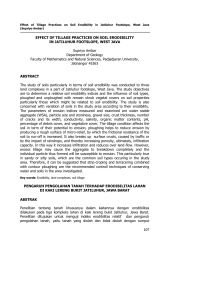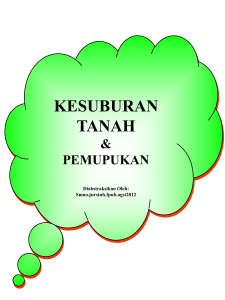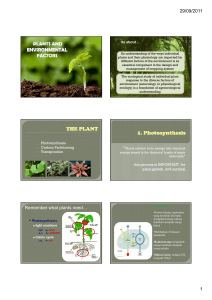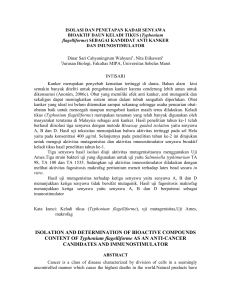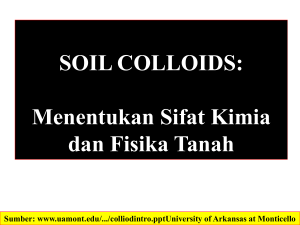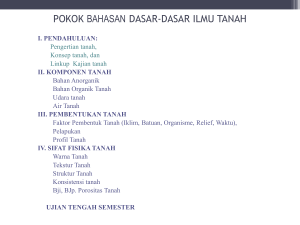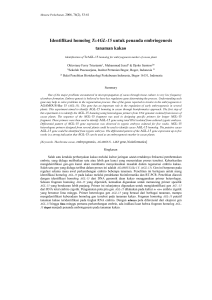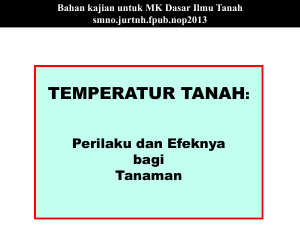kompendium evaluasi kesuburan tanah
advertisement
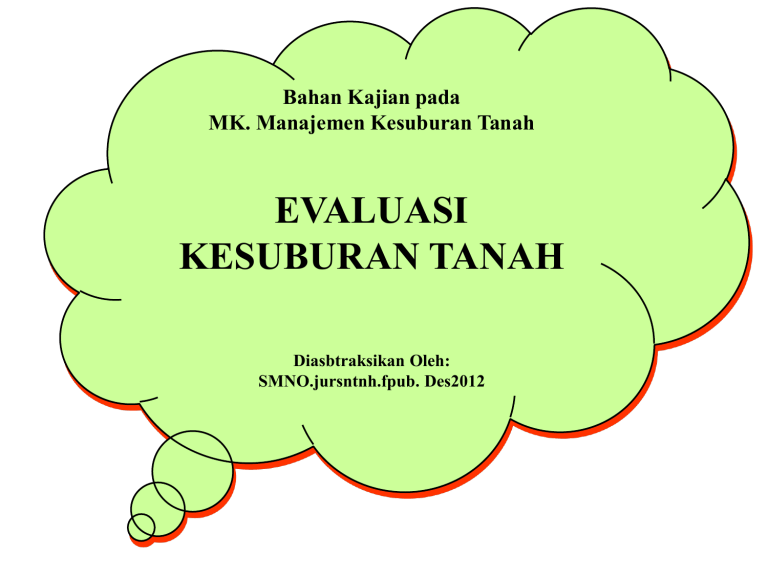
Bahan Kajian pada MK. Manajemen Kesuburan Tanah EVALUASI KESUBURAN TANAH Diasbtraksikan Oleh: SMNO.jursntnh.fpub. Des2012 PRODUKSI TANAMAN Kebutuhan tanaman terhadap hara Kemampuan tanah menyediakan hara bagi tanaman 1. Bertumpu pada unsur hara yang tersedia dalam tanah 2. 2. Penambahan unsur hara melalui pemupukan dan praktek pengelolaan lainnya Kemampuan tanah menyediakan unsur hara sangat beragam dan berfluktuasi Teknik Diagnosis/Pendugaan: 1. Identifikasi gejala defisiensi hara 2. Uji Tanah 3. Analisis jaringan tanaman TEKNIK PENDUGAAN STATUS KESUBURAN TANAH Identifikasi Gejala Defisiensi Unsur Hara pada tanaman Analisis jaringan tanaman yg tumbuh pada tanah Uji Biologis: Ukuran tingkat kesuburan tanah adalah pertumbuhan tanaman atau mikroorganisme tertentu UJI TANAH SECARA KIMIAWI “Proses diagnosis problematik hara dan pembuatan rekomendasi pupuk” Uji Tanah UJICOBA PUPUK Analisis Tanaman Missing Element Technique KOMBINASI NYA GEJALA DEFISIENSI UNSUR HARA PADA TANAMAN Pertumbuhan tanaman yg tidak normal dapat disebabkan oleh adanya defisiensi satu atau lebih unsur hara, gangguan dapat berupa gejala visual yang spesifik. Gejala defisiensi hara: 1. Kegagalan pertumbuhan pd saat perkecambahan 2. Pertumbuhan tanaman sangat kerdil 3. Munculnya gejala spesifik pad daun, pd waktu tertentu 4. Internal abnormalities, misalnya penyumbatan jaringan pembuluh 5. Tertundanya kemasakan tanaman 6. Penurunan hasil tanaman 7. Kualitas tanaman: kandungan protein, minyak, pati, daya simpan 8. ….. 1. 2. 3. Gejala defisiensi bersifat relatif, seringkali defisiensi satu unsur hara bersamaan dengan kelebihan unsur hara lainnya. Di lapangan tidak mudah membedakan gejala-gejala defisiensi. Tidak jarang gangguan hama dan penyakit menyerupai gejala defisiensi unsur hara mikro. “Situasi dimana tanaman memerlukan tambahan unsur hara tertentu meskipun belum ada gejala defisiensi yang spesifik” Kandungan hara dalam tanaman berada di atas zone defisiensi, namun masih berada di bawah batas optimal untuk pertumbuhan dan produksi tanaman HIDDEN HUNGER = KELAPARAN TERSEMBUNYI Melacak hidden hunger Optimum fisiologis Top yield Hidden hunger Optimum ekonomis Field trial Tissue test Plant analyses Feed value Morfologi Part analyses root absorption Soil tests Symptoms dosis pemupukan air tanah, aerasi, suhu Hasil analisis tanaman berguna untuk menyusun program pemupukan musim tanam mendatang . Hasil uji tanah berguna untuk membantu mengeliminir / mengatasi problematik hara musim tanam sekarang Kedua cara ini harus digunakan dengan hati-hati, terutama dikaitkan dengan sejarah pengelolaan tanah pada masa yang lalu Kekurangan hara dalam tanah diperparah oleh kondisi cuaca yang abnormal, misalnya kekeringan tanah atau kelebihan air yg menggenang, atau suhu tanah yang tdk normal. PENGARUH MUSIM Pengaruh temperatur thd kandungan N-P-K daun tomat Umur tanaman (hari) 36 50 60 110 Dry matter (%) N 12oC P K N 3.27 4.11 4.62 4.40 0.15 0.37 0.35 0.43 2.12 3.11 1.70 4.95 4.92 4.78 6.05 4.15 20oC P 0.38 0.44 0.47 0.62 K 4.23 4.40 3.12 4.20 Sumber: Zurbicki, 1960. Pada kondisi temperatur rendah, tanaman tomat menyerap lebih sedikit nitrogen, fosfat dan kalium. PENGARUH STRESS AIR TANAH Stress air tanah mempengaruhi penyerapan unsur hara oleh tanaman jagung. Kandungan NPK daun jagung lebih rendah pada kondisi stress air tanah. Pemupukan dapat mereduksi efek stress air tanah Pengaruh pemupukan N-P-K dan stress air tanah thd kadar NPK daun jagung Dosis pupuk N P K ……… kg/ha ……………. Kadar NPK No stress days Maximum stress ………………… % N …...……………. 0 179 78 78 47 47 179 179 0 78 47 47 179 179 39 39 0 93 2.0 2.9 ………………… % P …...……………. 0.26 0.32 ………………… % K …...……………. 1.1 1.6 Sumber: Voss, 1970. 1.5 2.2 0.12 0.18 0.7 1.2 ANALISIS TANAMAN (Plant Analyses) Dua macam analisis tanaman yg lazim adalah: 1. Tissue test, biasanya dilakukan pada jaringan segar tanaman di lapangan 2. Total analyses, dilakukan di laboratorium Analisis tanaman didasarkan pada premise bahwa: “ Jumlah unsur hara tertentu dalam tanaman merupakan indikasi dari ketersediaan unsur hara tersebut dalam tanah”. Karena kekurangan unsur hara tertentu akan membatasi pertumbuhan tanaman, maka kemungkinan unsur hara lain dalam tanaman menunjukkan konsentrasi tinggi. Tingkat kritis (critical level) unsur hara telah berhasil ditemukan pada berbagai jenis tanaman. Tingkat kritis adalah kandungan (content) suatu unsur hara dalam tanaman, di bawah mana hasil tanaman atau pertumbuhannya menurun di bawah optimum. Misalnya tingkat kritis P daun jagung pada masa pembungaan adalah 0.3% P. Ternyata besarnya tingkat kritis ini juga dipengaruhi oleh keseimbangan unsur hara lain dalam tubuh tanaman TISSUE TEST Uji Jaringan Tanaman Dalam uji ini digunakan cairan sel dari jaringan tanaman segar untuk mengetahui jumlah unsur hara yg masih belum terasimilasi, seperti N, P, K, Mg dan Mn. Hasil uji ini dikategorikan menjadi Sangat Rendah, Rendah, Medium,atau Tinggi GENERAL METHOD 1. The Purdue Soil and Plant Test Kit: Bagian tanaman dihancurkan dan diekstraks dengan reagen khusus. Intensitas warna yang berkembang diabndingkan dengan standar 2. Metode Kertas Saring. Cairan sel dipindahkan ke dalam kertas saring, kemudian dilakukan uji unsur hara N, P, K dengan menggunakan reagen tertentu. Bagian tanaman yang dianalisis Harus dipilih bagian tanaman yang dapt memberikan indikasi paling baik terhadap status hara tanaman. Bagian tanaman yg digunakan untuk Uji Jaringan Tanaman Tanaman Nitrogen Jagung Main stem , leaf midribs Leaf midribs near ear Kedelai - Petiole pd bagian atas tnm Petiole Biji-bijian Main stem Kentang dan Tomat Main stem, petiole Sumber: Ohlrogge, 1962. Fosfor Jaringan daun di dekat pusat tanaman Petiole pd bagian – bawah tnm Kalium Blade tissue, midrib near ear Sama dg Fosfor Petiole TIME OF TESTING 1. Tingkat kemasakan sangat penting dalam uji jaringan tanaman. 2. Umumnya tanaman semusim mengalami perubahan status hara selama masa pertumbuhannya 3. Umumnya periode kritis terjadi pada fase pembungaan atau antara pembungaan hingga awal pembuahan. Selama periode ini penggunaan unsur hara pada tingkat maksimum. 4. Kandungan nitrat biasanya lebih tinggi pd pagi hari, sehingga uji jaringan tdk boleh pagi-pagi. Beberapa hal penting: 1. Hal yg ideal adalah mengikuti serapan hara selama musim pertumbuhan dg jalan uji lapangan sebanyak lima atau enam kali. Biasanya kandungan hara lebih tinggi pada awal musim pertumbuhan 2. Kebutuhan tanaman paling besar biasanya terjadi pd saat masa pembungaan dan awal pembentukan buah dan biji 3. Pembandingan tanaman di lapangan sangat berguna. Uji tanaman dari daerah defisien dibandingkan dg tanaman dari daerah normal 4. Ragam tanaman, jumlah sampel 10 - 15 tanaman USE OF TISSUE TEST & PLANT ANALYSES 1. Membantu menentukan kemampuan tanah untuk menyediakan unsur hara. Hasil uji jaringan ini dipadukan dengan hasil uji tanah dan sejarah pengelolaan lahan. 2. Membantu mengidentifikasi gejala defisiensi 3. Membantu menentukan pengaruh pemupukan thd suplai hara dlm tanaman. Hal ini sangat penting untuk mengukur pengaruh pupuk meskipun tidak ada respon hasil. Dalam banyak kasus, hara ppuk tidak dapat diserap tanaman karena penempatannya keliru, cuaca kering, pencucian, fiksasi oleh tanah, atau aerasi buruk 4. Mengkaji hubungan antara status hara tanaman dengan penampilan tanaman 5. Survei daerah yang luas 6. Menarik partisipasi banyak orang. INPERPRETASI TISSUE TEST & PLANT ANALYSES Interpretasi hasil uji dan analisis tanaman harus dikaitkan dengan proses fisiologi tanaman. Beberapa faktor penting yang harus dipertimbangkan adalah: 1. 2. 3. 4. Performance dan vigor tanaman secara umum Kandungan unsur hara lainnya dalam tanaman Adanya gangguan hama dan penyakit Kondisi tanah, seperti aerasi yg buruk, kemasaman tanah, suhu tanah 5. Kondisi air tanah, stress air , genangan air 6. Kondisi klimatik 7. Waktu dalam seharian: pagi, siang, sore, malam. 1. Umumnya kalau pada awal pertumbuhannya tanaman mempunyai kandungan N,P, atau K yang rendah hingga medium, maka hasil tanaman akan di bawah optimum 2. Pada saat pembungaan hasil uji medium hingga tinggi dianggap cukup untuk kebanyakan tanama n TOTAL ANALYSES Analisis Total dilakukan pada sluruh tanaman atau bagianbagian tanaman. Bahan tanaman dikeringkan, dihaluskan dan diabukan. Bahan abu tanaman kemudian diekstraks dengan reagen kimia. 1. Kalau kadar K daun bagian bawah lebih rendah dari kadar K daun bagian atas, maka tanaman defisiensi kalium. 2. Peningkatan hasil dg peningkatan kadar hara 3. Keseimbangan hara 4. Time of sampling: Kadar hara tanaman menurun mulai dari awal hingga akhir masa pertumbuhannya 5. Crop Logging: Penggunaan analisis tanaman dalam operasi produksi tanaman 6. A-Value Technique: Teknik Analisis Radio-kimiawi Pemupukan N menurunkan kadar P dan K tanaman tebu umur 10 bulan Dosis pupuk N (lb/A) Nitrogen (ppm) 0 300 Sumber: Burr, 1960. 229 463 Internode 8-10 : Fosfor (ppm) 131 57 Kalium (ppm) 1160 340 Hasil tanaman jagung (Y) Hasil tanaman jagung (Y) Y = 1.20 + 31.88 X r = 0.96 (Hanway, 1962) at tasseling (Loue, 1963) Kadar K daun jagung (X) Kadar N daun jagung (X) Kadar Ca atau Mg daun jagung (Y) Kadar K petiole Dosis pupuk K = 400 kg/ha 200 (Loue, 1963) Mg Ca 100 0 (Tyler et al., 1960) Kadar K daun jagung (X) Umur tanaman kentang BIOLOGICAL TESTS FIELD TEST. Percobaan lapangan melibatkan berbagai perlakuan pemupukan pada sebidang lahan. Biasanya digunakan Rancangan Percobaan tertentu Ukuran petakan contoh tgt jenis tanaman dan jatak tanamnya STRIP TESTS ON FARMERS FIELDS Sepetak lahan petani diperlakukan dengan “pemupukan” yang direkomendasikan berdasarkan hasil uji tanah dan/atau analisis tanaman. LABORATORY & GREENHOUSE TESTS 1. Mitscherlich Pot Culture 2. Neubauer Seedling Method 3. Sunflower Pot Culture technique for Boron METODE MIKROBIOLOGIS 1. Sackett & Stewart Technique 2. Aspergillus Niger 3. Mehlich Cunninghamella-Plaque Method for Phosphorus Ketersediaan dan keseimbangan hara dalam tanah SAMPLING: Tanah & Tanaman Interpretasi & Rekomendasi Analisis Laboratorium Korelasi antara hasil analisis & respon tanaman Contoh Tanah representatif : 1. Terdiri 10-20 subsample dari zone perakaran: 0-20 cm 2. Sebidang lahan yg seragam slope, drainage, warna, dan sejarah pemupukannya 3. Area non-representatif: fence row, manure pile 4. Informasi pelengkap: petani, nomor lapangan, tanaman, praktek pemupukan 5. Waktu sampling 6. Sampel komposit: 500 g, ditumbuk, diayak 2 mm TUJUAN UJI TANAH 1. Untuk mempertahankan status kesuburan sebidang lahan 2. Untuk meramalkan / menduga respon kapur dan pupuk yg menguntungkan 3. Untuk mendapatkan landasan bagi rekomendasi jumlah kapur dan pupuk 4. Untuk mengevaluasi status kesuburan tanah di suatu wilayah SOIL TEST LEVEL Sumber Unsur Hara Tanah Pupuk Tinggi Tanah Pupuk Medium Tanah Pupuk Rendah Tanah Pupuk Sgt Rendah Tanah Pupuk Sgt Tinggi Unsur hara yg tersedia dari dlm tanah Unsur hara yg diperlukan dari pupuk SAMPLING THE SOIL UJI TANAH 1. 2. 3. 4. Contoh tanah harus dapat mewakili kondisi daerah / lahan Seringkali digunakan contoh tanah komposit Peralatan sampling tanah Area sampling: satu contoh mewakili liasan lahan tertentu DEPTH OF SAMPLING 1. Untuk tanah-tanah pertanian, kedalaman sampling 15 - 30 cm 2. Kedalaman ini biasanya merupakan lapisan olah tanah 3. Untuk keperluan deskripsi profil tanah, sampling dilakukan untuk setiap horison tanah TIME OF SAMPLING 1. Sampling dapat dilakukan setiap saat asalkan kondisi tanah memungkinkan 2. Rekomendasi umum adalah melakukan uji tanah setiap tiga tahun 3. Sampling tanah dapat dilakukan pada saat tanaman sedang tumbuh ANALYZING THE SOILS 1. Kation: NH4+, K+, Ca++, Mg++ 2. Fosfor 3. Unsur mikro 4. N dan Bahan organik 5. Kemasaman tanah dan kebutuhan kapur 6. Belerang 7. Sifat Fisika Tanah 8. …... Hasil uji tanah harus dikalibrasikan dengan respon tanaman thd penambahan unsur hara (pupuk) . Respon tanaman dapat diperoleh dari percobaan lapangan atau rumah kaca. Indeks kesuburan tanah = “relative sufficiency” yg dinyatakan sbg persentase dari jumlah yang diperlukan untuk mencapai hasil maksimum KALIBRASI UJI TANAH Indeks Kesuburan (%) Sangt Rendah Rendah Medium 0 - 50 60-70 80-100 Tinggi Sngt Tinggi Ekstrem Tinggi Tingkat kritis = Indeks kesuburan 75 % Peluang respon pupuk S. Rdh Rndh Medium Tingkat kesuburan tanah Tinggi Indeks Kesuburan (%) Sgt Tinggi 110 - 200 210 - 400 > 410 INTERPRETASI SOIL TEST Masalah penting dalam menginterpretasikan hasil uji tanah adalah kaitannya dengan “pemupukan” yang diperlukan. Beberapa faktor yg harus diperhatikan adalah: 1. Karakteristik tanah 2. Hasil yang diharapkan 3. Tindakan pengelolaan 4. Kondisi agroklimat Konsep hasil relatif (% hasil) didasarkan atas idea bahwa hasil yang diharapkan (yg dinyatakan sebagai persentasi hasil maksimum) diduga dari hasil uji tanah P dan K. Sejumlah pupuk perlu ditambahkan untuk mencapai hasil tanaman hingga 95% hasil maksimum. Kelemahan konsep ini adalah kalau ada efek interaksi antar unsur hara. Hasil Penelitian Barber (dari Purdue University) disajikan berikut: Populasi tanaman jagung dan respon pupuk Populasi jagung (tnm/A) 15.700 24.500 Sumber: Barber, 19… Respon jagung (bu/A) thd pemupukan : Dosis 100 lb P2O5 Dosis 200 lb K2O 2 21 22 39 REKOMENDASI PUPUK 1. Interpretasi hasil uji tanah melibatkan evaluasi ekonomi terhadap hubungan antara nilai uji tanah dengan respon pupuk. 2. Potensial respon pupuk dipengaruhi oleh faktor-faktor tanah, agroklimat, dan pengelolaan oleh petani 3. Rekomendasi pemupukan nitrogen sangat dipengaruhi oleh tanaman musim sebelumnya dan sasaran hasil 4. Untuk sistem komersial, sasarannya adalah mempertahankan hara tanah pd tingkat untuk melestarikan “top profit” per hektar lahan. Unsur hara tdk boleh menjadi faktor pembatas selama pertumbuhan tanaman. Hasil tanaman D C B A Dosis pupuk Respon hasil thd pemupulan tgt pd potensial hasil tanaman A: terendah; D: tertinggi 1. BUILDUP / Basic Treatment TIPE REKOMENDASI Pemupukan bersifat korektif, untuk meningkatkan ketersediaan hara tanah hingga taraf yang diperlukan Uji tanah harus dilakukan setiap 2 - 3 tahun untuk memperbaiki dosis pupuk untuk mengganti kehilangan karena dipanen, erosi, pencucian dan fiksasi. 2. ANNUAL APPLICATION Pupuk P dan K ditambahkan kepada setiap tanaman dalam rotasi untuk mempertahankan hasil uji tanah 3. ROTATION. a. b. c. d. e. Beberapa faktor yg harus diperhatikan: Pemupukan dilakukan sebelum tanaman yg paling responsif & profitable Row-application pupuk P untuk jagung Forage-crop menyerap banyak K, perlu pemupukan setiap tahun Kedelai punya respon lebih baik thd kesuburan tanah yg tinggi daripada pemupukan langsung Dalam sistem pergiliran tanaman dlm setahun, pemupukan dilakukan pd tanaman yg paling responsif 4. REPLACEMENT SYSTEM Dosis pupuk ditentukan berdasarkan jumlah hara yang diambil tanaman untuk menghasilkan tingkathasil tertentu. Beberapa faktor yg harus diperhatikan adalah: a. Kemampuan tanah menyediakan unsur hara, termasuk kemampuan fiksasi hara b. Tingkat kecukupan hara dalam tanah c. Kandungan hara dalam hasil panen d. Kemampuan tanaman menyerap hara tanah. 1. Metode ini didasarkan pada gagasan bahwa tanaman dapat memanfaatkan sejumlah tertentu unsur hara yg terkandung dlm tanah, pupuk dan rabuk. 2. Kalau jumlah hara yang diperlukan untuk mencapai hasil tertentu dapat diketahui, maka jumlah tambahan pupuk dan rabuk dapat dihitung 3. Rekomendasi pupuk dipengaruhi oleh: sistem rotasi, tindakan pengelolaan, analisis tanah, dan tanaman yang akan ditanam 4. Contoh untuk tanaman jagung sbb: Estimasi persentase ketersediaan N, P, K dari tiga sumber: Sumber Persentase yg diperoleh selama satu musim: Nitrogen Fosfor Kalium Tanah (available) Rabuk (total) Pupuk (available) 40 30 60 Sumber: Berger, 1954. 40 30 30 40 50 50 BEBERAPA PRINSIP PENTING Praktek pengapuran dan pemupukan yang tepat sangat tergantung pada kebutuhan tanaman, agroklimat, karakteristik tanah dan metode analisis defisiensi dlm tanah Pendekatan diagnostik dalam uji tanah dan analisis tanaman lebih utama untuk tindakan pencegahan Gejala defisiensi merupakan sarana yang sangat bermanfaat di daerah / lahan yang baru dilakukan pemupukan. Di daerah yang telah dikelola secara intensif, interpretasi gejala defisiensi sangat sulit karena adanya komplikasi dari berbagai faktor HIDDEN HUNGER merupakan bahaya tersembunyi, tetapi uji tanah & tanaman yang hati-hati dapat membantu menghindari bahaya ini Tanaman mengintegrasikan semua faktor lingkungan tumbuhnya ke dalam kehidupannya, uji tanah dapat menjadi sangat bermanfaat. Analisis jaringan tanaman yg sedang tumbuh di lapangan sangat berguna, namun harus diinterpretasikan secara hati-hati. BEBERAPA PRINSIP PENTING Kalau unsur hara ditambahkan melalui pemupukan, kandungan hara dalam tanaman akan meningkat. Dalam kaitan ini penting untuk ditentukan suatu titik (kadar hara tanaman) dimana tidak terjadi lagi peningkatan hasil ekonomis tanaman Analisis tanaman sangat penting untuk mengetahui / menganalisis problematik unsur hara mikro di suatu area lahan. Keseimbangan di antara unsur hara dalam tubuh tanaman sama pentingnya dengan jumlah aktual masing-masing hara tsb. Misalnya hubungan di antara Ca-Mg-K-NH4 ; Mn-Fe-Zn-P Prinsip uji tanah adalah mencari nilai yg dapat digunakan untuk menduga jumlah unsur hara yang diperlukan untuk menambah ketersediaan dalam tanah. Hasil uji tanah ini harus dikalibrasikan dengan percobaan pemupukan di lapangan dan rumah kaca. Harus diingat bahwa kesuburan tanah hanyalah salah satu faktor yg mempengaruhi produksi tanaman Ciri-ciri fisika tanah menjadi semakin penting kalau kondisinya telah mendekati “top profitable yield”; namun perlu diidentifikasi lebih lanjut ciri-ciri fisika mana yang “cocok” dan mana yang tidak cocok. BEBERAPA PRINSIP PENTING Rekomendasi yang disusun untuk mendapatkan hasil yang lebih tinggi seyogyanya ditujukan pada: to maintain foil fertility at a level for top profit yields. Ada empat macam pendekatan dalam menusun rekomendasi: 1. Build-up dengan dosis pemupukan yang tinggi 2. Annual application, pemupukan setiap musim tanaman dlm sistem rotasinya 3. Rotational fertilization 4. Replacement, mengganti unsur hara yang dipanen Pemupukan tanaman dimaksudkan untuk mensuplai unsur hara yang ketersediaannya dalam tanah tidak mencukupi kebutuhan tanaman untuk menghasilkan maximum net return. Hasil atau nilai hasil Tingkat pengelolaan yg baik Tingkat pengelolaan rata-rata Biaya pupuk A B Dosis pupuk MODEL EVALUASI KESUBURAN TANAH DAN REKOMENDASI PEMUPUKAN 1. Pendekatan yang Digunakan 2. Gejala Defisiensi Unsur Hara 3. Kelaparan Tersembunyi 4. Analisis Jaringan Tanaman 5. Uji Biologis 6. Uji Tanah Diunduh dari: smno fpub ……….. 6/10/2012 UJI TANAH = SOIL TESTING 1. Uji tanah merupakan metode kimiawi untuk mengestimasi kemampuan tanah mensuplai unsur hara. 2. Uji tanah secara kimiawi dapat menentukan dugaan kebutuhan hara sebelum tanaman ditanam. 3. Uji tanah mengukur sebagian dari total suplai hara dalam tanah. 4. Untuk dapat menggunakan hasil evaluasi ini untuk menduga kebutuhan unsur hara suatu tanaman maka harus dikalibrasikan dengan percobaan pemupukan di lapangan dan di rumah kaca. Diunduh dari: ……….. 6/10/2012 UJI TANAH = SOIL TESTING Tujuan Uji Tanah 1. Untuk mempertahankan status kesuburan tanah di suatu bidang lahan. 2. Untuk memperkirakan peluang respon yang menguntungkan terhadap kapur dan pupuk. 3. Untuk memberikan landasan bagi rekomendasi dosis kapur dan pupuk. 4. Untuk mengevaluasi status kesuburan tanah di suatu wilayah. Diunduh dari: ……….. 6/10/2012 UJI TANAH = SOIL TESTING Tujuan uji tanah adalah untuk mendapatkan "suatu nilai" yang akan membantu meramalkan jumlah unsur hara yang diperlukan untuk menunjang suplai unsur hara dalam tanah. Misalnya, tanah yang menunjukkan nilai uji tanah "tinggi" tidak akan memerlukan banyak tambahan pupuk. Diunduh dari: ……….. 6/10/2012 UJI TANAH = SOIL TESTING Keterkaitan antara hasil uji tanah dengan rekomendasi dosis pupuk (Tisdale dan Nelson, 1975) Hasil Uji Tanah Proporsi sumber unsur hara tanah pada berbagai nilai uji tanah Sagt Tinggi TANAH Tinggi TANAH Medium Rendah Sngt Rendah PUPUK PUPUK TANAH PUPUK TANAH PUPUK TANAH PUPUK Unsur hara dari tanah Unsur Hara dari Pupuk Diunduh dari: ……….. 6/10/2012 UJI TANAH = SOIL TESTING PENGAMBILAN CONTOH TANAH Salah satu aspek yang sangat penting dari uji tanah adalah cara mendapatkan contoh tanah yang dapat mewakili daerah yang diuji. Biasanya contoh tanah komposit sebanyak 500-1000 g diambil dari suatu bidang lahan. Dengan demikian prosedur pengambilan contoh tanah harus benar-benar diikuti. Analisis kmiawi di laboratorium menggunakan contoh tanah. Kalau contoh tanah yang diambil tidak mewakili kondisi lapangan maka hasil rekomendasinya juga akan keliru. Pada umumnya kesalahan sampling tanah di lapangan lebih besar dibandingkan dengan kesalahan di laboratorium. Diunduh dari: ……….. 6/10/2012 UJI TANAH = SOIL TESTING Menganalisis Contoh Tanah Suatu uji tanah secara kimiawi harus dirancang untuk memungkinkan perkiraan jumlah unsur hara yang berhubungan dengan fraksi pertukaran kation, fraksi yang mengikat fosfat, dan dalam kondisi tertentu diharapkan juga mampu memperkirakan unsur hara yang berhubungan dengan dekomposisi bahan organik. Beberapa macam larutan pengekstraks telah banyak digunakan dalam rangka untuk mengkorelasikan hasil uji tanah dengan pertumbuhan tanaman. Menurut Bray (1948), tingkat kehandalan metode ekstraksi tanah ditentukan oleh tiga hal, yaitu 1. 2. 3. harus mampu mengekstraks semua atau sebagian bentuk unsur hara tersedia dalam tanah yang cirinya berbeda-beda, prosedur ekstraksinya harus cepat dan akurat, jumlah unsur hara yang terkestraks harus berkorelasi dengan pertumbuhan dan respon tanaman terhadap unsur hara yang terkait pada berbagai kondisi. Diunduh dari: ……….. 6/10/2012 UJI TANAH = SOIL TESTING Larutan pengekstraks P-tanah, mulai dari air, alkalin, hingga asam-asam lemah yang dicampur dengan asam-asam yang relatif kuat dan ammonium fluorida telah banyak digunakan untuk ekstraksi fosfat. Korelasi antara hasil uji P-tanah dengan fraksi P-anorganik dalam tanah dari Bangladesh. Uji tanah Pengekstraks Ca-P Al-P Fe-P Olsen 0.5M NaHCO3 pH = 8.5 0.55 0.62 0.78* Truog 0.002N H2SO4 pH = 3 0.90* 0.59 0.09 North Car. 0.025N H2SO4+0.05N HCl 0.88* 0.65* 0.06 HCl Bray 1 0.3 N HCl 0.03 +0.025N HCl 0.95* 0.72* 0.70* 0.73* 0.23 0.46 Bray 2 0.3 N NH4F+0.025N HCl 0.78* 0.74* 0.38 Schoefield Morgan EDTA 0.01M CaCl2 NaOAc + HOAc 0.02N Na2-EDTA 0.06 0.79* 0.77* 0.05 0.56 0.95* 0.03 0.18 0.41 Sumber: Ahmed dan Islam (1975) Dalam Sanchez, 1976. UJI TANAH = SOIL TESTING Metode uji tanah, faktor-faktor tanah yang mempengaruhi interpretasinya, dan kisaran kritis unsur mikro. Unsur hara B Cu Faktor yang berpengaruh Esensial Tekstur; pH Fe Probable Kapur B.O. pH; Kapur Mn pH Mo Zn pH pH; kapur B.O. Fe, P, S P Metode Ekstraksi Kisaran tingkat H2O panas Fe NH4C2H3O2 (pH 4.8) 0.5 M EDTA 0.43N HNO3 Biologis NH4C2H3O2(pH 4.8) DTPA+CaCl2(pH7.3) 0.05N HCl+0.025N H2SO4 0.1N H3PO4 dan 3N NH4H2PO4 Hydroquinone+ NH4C2H3O2 H2O (NH4)2C2O4 pH=3.3 0.1N HCl Dithizone+NH4C2H3O2 EDTA+(NH4)2CO3 DTPA+CaCl2 pH 7.3 kritis (ppm) 0.1-0.70 0.20 0.75 3-4.00 2-3.00 2.00 2.5-4.5 5-9 15-20 25-65 2 0.04 – 0.2 1-7.5 0.3-2.3 1.4-3.0 0.5-1.0 Sumber: Sanchez, 1976. UJI TANAH = SOIL TESTING Korelasi dan Kalibrasi Uji Tanah Aspek-aspek yang sulit dalam proses evaluasi kesuburan tanah adalah korelasi, interpretasi dan rekomendasi, karena melibatkan fenomena yang rumit. Nilai uji tanah itu sendiri belum mampu memberikan banyak informasi, ia hanya merupakan nilai empiris yang bisa atau tidak-bisa mencerminkan ketersediaan unsur hara. Nilai ini akan menjadi lebih bermakna kalau mempunyai korelasi yang baik dengan respon tanaman. Kajian korelasi seperti ini biasanya dilakukan pada dua tingkat, yaitu tingkat kajian di rumah kaca yang melibatkan berbagai kondisi tanah, dan kajian lapangan yang lebih definit dengan melibatkan lokasi (lapangan) yang dipilih secara hati-hati. Diunduh dari: ……….. 6/10/2012 UJI TANAH = SOIL TESTING Tujuan pokok dari kajian korelasi di rumah kaca adalah untuk membandingkan berbagai metode ekstraksi dan menentukan tingkat kritis "tentatif". Sedangkan kajian lapangan bertujuan untuk menetapkan tingkat kritis yang "definit" untuk suatu metode ekstraksi yang terpilih. Pada hakekatnya hasil uji tanah dikalibrasikan dengan respon tanaman terhadap pemupukan di lapangan. Respons pertumbuhan dan hasil tanaman dari berbagai dosis pupuk dapat dihubungkan dengan jumlah unsur hara yang tersedia dalam tanah. Diunduh dari: ……….. 6/10/2012 UJI TANAH = SOIL TESTING Apabila hasil tanaman berkorelasi dengan suatu peubah tertentu, misalnya P-tersedia dalam tanah, maka hal ini berarti bahwa Ptersedia tersebut merupakan faktor pembatas yang lebih penting dibandingkan ppeubah-peubah lainnya yang tidak dikendalikan dalam suatu kajian korelasi . Diunduh dari: ……….. 6/10/2012 UJI TANAH = SOIL TESTING Hasil penelitian Hauser (1973) tentang korelasi hasil analisis P-tanah dengan respon kapas: Hasil analisis P-tanah dikelompokkan menjadi tiga kategori, yaitu rendah, medium dan tinggi. Dosis rekomendasi didasarkan pertimbangan jumlah pupuk yang diperlukan untuk menaikkan nilai analisis P-tanah menjadi kategori "tinggi". Respon hasil kapas, kg/ha RENDAH Hasil analisis tanah, ppm P SEDANG TINGGI UJI TANAH = SOIL TESTING Cate dan Nelson (1965) mengemukakan suatu metode plotting hasil relatif (persen dari hasil maksimum) sebagai fungsi dari nilai-nilai analisis tanah. Diagram pencar titik-titik dibagi menjadi empat kuadran oleh garis vertikal dan horisontal. Kedua garis ini digeser-geser sedemikian rupa sehingga banyaknya titik-titik yang berada pada kuadran kiri bawah dan kanan atas mencapai maksimum, dan titik-titik yang berada pada kuadran kiri atas dan kanan bawah mencapai minimum. Diunduh dari: ……….. 6/10/2012 An overview of fertilizer-P recommendations in Europe: soil testing, calibration and fertilizer recommendations L. Jordan-Meille , G. H. Rubæk , P. A. I. Ehlert , V. Genot , G. Hofman , K. Goulding , J. Recknagel , G. Provolo , P. Barraclough Soil Use and Management. Volume 28, Issue 4, pages 419–435, December 2012 The procedure for applying phosphorus (P) fertilizer to soil can be divided into three consecutive steps: (i) Measurement of soil-P availability, (ii) calibration of the soil-P fertility level and (iii) estimation of the recommended P dose. Information on each of these steps was obtained for 18 European countries and regions with the aim of comparing P fertilizer recommendation systems at the European scale. We collected information on P fertilizer recommendations through conventional or grey literature, and personal contacts with researchers, laboratories and advisory services. We found much variation between countries for each of the three steps: There are more than 10 soil-P tests currently in use, apparent contradictions in the interpretation of soil-P test values and more than 3-fold differences in the P fertilizer recommendations for similar soil-crop situations. This last result was confirmed by conducting a simple experimental inter-laboratory comparison. Moreover, soil properties (pH, clay content) and crop species characteristics (P responsiveness) are used in some countries in the calibration and recommendation steps, but in different ways. However, there are also common characteristics: soil-P availability is determined in all countries by extraction with chemical reagents and the calibration of the soil-P test values, and the fertilizer recommendations are based on the results from empirical field trials. Moreover, the fertilizer recommendations are nearly all based on the amount of P exported in the crops. As long as rational scientific and theoretical backgrounds are lacking, there is no point in trying to synchronize the different chemical methods used. We therefore call for a mechanistic approach in which the processes involved in plant P nutrition are truly reproduced by a single standard method or simulated by sorption-desorption models. Diunduh dari: onlinelibrary.wiley.com › ... › Vol 28 Issue 4 ……….. 6/12/2012 Soil Testing to Predict Phosphorus Leaching Rory O. Maguire and J. Thomas Sims JEQ. Vol. 31 2002 No. 5, p. 1601-1609 Subsurface pathways can play an important role in agricultural phosphorus (P) losses that can decrease surface water quality. This study evaluated agronomic and environmental soil tests for predicting P losses in water leaching from undisturbed soils. Intact soil columns were collected for five soil types that had a wide range in soil test P. The columns were leached with deionized water, the leachate analyzed for dissolved reactive phosphorus (DRP), and the soils analyzed for water-soluble phosphorus (WSP), 0.01 M CaCl2 P (CaCl2–P), iron-strip phosphorus (FeO-P), and Mehlich-1 and Mehlich-3 extractable P, Al, and Fe. The Mehlich-3 P saturation ratio (M3-PSR) was calculated as the molar ratio of Mehlich-3 extractable P/[Al + Fe]. Leachate DRP was frequently above concentrations associated with eutrophication. For the relationship between DRP in leachate and all of the soil tests used, a change point was determined, below which leachate DRP increased slowly per unit increase in soil test P, and above which leachate DRP increased rapidly. Environmental soil tests (WSP, CaCl2–P, and FeO-P) were slightly better at predicting leachate DRP than agronomic soil tests (Mehlich-1 P, Mehlich-3 P, and the M3-PSR), although the M3-PSR was as good as the environmental soil tests if two outliers were omitted. Our results support the development of Mehlich-3 P and M3-PSR categories for profitable agriculture and environmental protection; however, to most accurately characterize the risk of P loss from soil to water by leaching, soil P testing must be fully integrated with other site properties and P management practices. Diunduh dari: https://www.agronomy.org/publications/jeq/abstracts/31/5/1601……….. 6/12/2012 . Effective Factors on Adoption of Soil Testing for Farm Fertilizer Nutrition in Shahreza Township of Esfihan Province, Iran Saeid Fe`li , Nooshin Bondarian, Mosayeb Baghaei and Arezoo Mirzaei Research Journal of Soil and Water Management . 2010 . Vol. 1 Issue: 2. Page No.: 38-44 Soil testing is a general soil productivity evaluation program that helps farmers touse chemical fertilizers wisely. The purpose of this study was to investigate the effective factors on adoption of soil testing for fertilizing farms. The research instrument was astructural questionnaire with close ended questions which confirmed its validity andreliability. The target population included all farmers in the Shahreza township of Esfihan Province (N = 9,825). Among of them, 215 persons were chosen by using the Cochran formula through stratified sampling as the statistical sample and finally 195 questionnaires were analyzed (n = 195). There was a significant difference between the personal, farming and educational characteristics of adopters and non-adopters of soil testing. The result of discriminate analysis showed that knowledge about soil sampling principles, the amount of extensional contacts about soil testing and educational level were identified as the most discriminative factors (74.40% of population) affecting the adoption of soil testing. Diunduh dari: http://www.medwelljournals.com/abstract/?doi=rjswm.2010.38.44……….. 6/12/2012 I GUSTI MADE SUBIKSA, SUPIYANDI SABIHAM. JURNAL TANAH DAN IKLIM NO. 30/2009 . Soil testing calibration is a process to provide meaning of soil test value in term of crops response. Research on soil testing calibration for corn has been carried out on Typic Hapludox Cigudeg. The objectives were: 1) to determine critical point of soil test value of K, 2) to determine the application rate of K fertilizer recommendation. The split plot design was used with consisted five rate of K fertilization on three K soil status as the main plots. There were four K soil test methods assessed to determine the critical point value for corn. K availability was classified into three categories namely low, medium, and high class. The results revealed that critical value of four soil testing methods for low, medium, and high respectively were : HCl 25% (<14, 14-29, and >29 mg 100 g-1), NH4OAc pH 7(<84 ppm, 84-220 ppm, and >220 ppm), Morgan (<70 ppm, 70-180 ppm, and >180 ppm), and Mechlich I (<54 ppm, 54-135 ppm, and >135 ppm). K fertilization significantly affected to corn plant height in the low soil K status until the rate of 60 kg K ha-1 (116 kg KCl ha-1). Dry biomass significantly increased due to K fertilization on low, medium as well as high soil K status. K fertilization also improved corn grain production. The ears of corn could not develop without K fertilization. This was an evidence that K nutrient has an important role in enzyme activity and assimilate translocation. Even with low rate of K fertilization, corn has succeeded to form ears and kernels. In the low soil K status, K fertilization sharply increased dry grain, but in the medium soil K status the curve was gentler. Whereas in the high soil K status, K fertilization did not significantly affect the dry grain yield. The recommended application rate of K fertilization for corn on Typic Hapludox Cigudeg with low K status was 89 kg K ha-1 and in the medium status was 53 kg K ha-1. Whereas in the high soil K status, no K fertilization was needed. Diunduh dari: http://124.81.86.163/ojs/index.php/jti/article/view/221 ……….. 6/12/2012 Soil testing and plant analysis in Australia. Peverill, K.I. Australian Journal of Experimental Agriculture. [1993, 33(8):963-971] During the past 3-4 decades, there has been a modest growth in the demand for soil amd plant testing services in Australia. Such development reflects an increasing awareness by farmers that there are tangible benefits from the regular use of soil and plant analysis. Concomitant with these changes, there has been an increasing breadth and sophistication in the range of available services, instrumental advances that permit more rapid analytical throughput, evolution of computer management systems (including computer-generated reports), and a general decrease in reporting time to primary producers. These developments have not always been matched with adequate quality control and uniformity in sampling, analysis, interpretation, and fertiliser advice procedures. There is need for further research and method development leading to the introduction of universal reagents or ion exchange resin extractions, or new test procedures into laboratory routines, to enhance laboratory capacities and turnaround times or to improve interpretation skills. Advances in decision support software are also required in order to refine fertiliser advice to primary producers. The challenge for the future is the standardisation of procedures and maintenance of adequate quality control by the various agencies offering soil and plant testing services. The Australian Soil and Plant Analysis Council (ASPAC) will play a pivotal role in this process. Diunduh dari: http://europepmc.org/abstract/AGR/IND20452684……….. 6/12/2012 Soil Health and Sustainable Crop Production: Adoption and Awareness of Soil Testing. Asthana A, Kumar Sushil Journal of Sustainable Agriculture. [2008, 32(2):303-320] Maintenance of proper soil fertility, through application of a balanced mix of various nutrients, is important for maintaining sustainable crop production levels. Soil testing is a crucial step in this direction. This paper describes soil testing as a multi-dimensional concept comprising seven aspects. Awareness of these factors among farmers is computed, examined, and statistically analyzed using survey data collected from three categories of farmers--small, medium and large--in four districts of the Uttar Pradesh state in India. The impact of a World Bank-aided project--Diversified Agriculture Support Project--is also assessed in terms of dissemination of soil testing knowledge. Results indicate that project interventions had a significant and variable soil impact on farmers awareness of and likelihood of adopting soil testing in four districts. The findings have implications for policy-makers and researchers who are interested in improving the production and productivity of crops in developing economies. Diunduh dari: http://europepmc.org/abstract/AGR/IND44094634……….. 26/12/2012 Correlation of Plant Tissue Tests of Corn, Deficiency Symptoms, and Soil Analyses on the Jordan Fertility Plots B. N. Driskell and A. C. Richer SSSAJ. Vol. 16 No. 3, p. 270-270. July, 1952 Nitrogen. — An excellent correlation at the 0.1% level of significance was found between tissue tests and visual deficiency symptoms on tiers 1 and 2; however, no correlation was found between the tissue tests and potential nitrification of the soil or visual deficiency symptoms and potential nitrification of the soil. Phosphorus. — Highly significant correlations were found in all instances, namely, between (1) soil tests and tissue tests, (2) soil tests and deficiency symptoms, and (3) tissue tests and deficiency symptoms. Potassium. — All correlation coefficients were significant at the 0.1% level between exchangeable soil potassium and tissue tests, exchangeable soil potassium and deficiency symptoms, and tissue tests and deficiency symptoms. Magnesium. — The correlation coefficients between exchangeable magnesium and tissue tests on the limed tier were not significant at the 5% level but were significant on the acid tier. Significance at either the 1% or the 0.1% level was found between exchangeable soil magnesium versus deficiency symptoms and tissue tests versus deficiency symptoms. Good correlations were obtained in most instances between soil tests, tissue tests, and deficiency symptoms, but no one test is always conclusive. Diunduh dari: https://www.soils.org/publications/sssaj/abstracts/16/3/SS0160030270a……….. 6/10/2012 The Relationship Between Soil Tests for Available Nitrogen and Nitrogen Uptake by Various Irrigated Crops in the Western States W. F. Spencer, A. J. MacKenzie and F. G. Viets. SSSAJ. Vol. 30 No. 4, p. 480-485. July, 1966 Soil tests for available N were evaluated by determining the relationship between N uptake from a non-N fertilized plot, as a direct measure of the amount of N available to a crop, and available N as measured by various laboratory methods. Field experiments were conducted with four irrigated crops, corn (Zea mays), sugar beets (Beta vulgaris L.), sorghum (Sorghum vulgare), and cotton (Gossypium hirsutum) on neutral to calcareous soils in California, Nebraska, or Washington. Initial nitrate N, nitrifiable N released on incubation for 2- and 4-week periods, and total N in soil samples from 0- to 6- and 6- to 12-inch depths were combined to give 14 measures of available N for correlation with N uptake. Highly significant correlations were obtained between N uptake from no-N plots and all soil test values, with the exception of NO3-N released on incubation for 4 weeks. Nitrogen uptake by corn was most highly correlated with initial NO3-N, 6–12 inches; initial NO3-N plus N released on incubation for 2 weeks; and total N, 0–12 inches. The coefficient of determination for these relationships indicated that variations in soil test values were associated with approximately 50% of the variation in N uptake from no-N plots. Combining the effects of initial NO3-N and total N in a multiple-regression analyses slightly improved the prediction of N uptake by corn and sugar beets growing in Nebraska. With cotton growing on desert soils low in organic matter, initial NO3-N, 0–12 inches, was most highly correlated with N uptake, and combining the effect of initial NO3-N and total N did not improve the prediction of N uptake. Diunduh dari: https://www.soils.org/publications/sssaj/abstracts/30/4/SS0300040480……….. 6/10/2012 A Soil Test for Nitrogen Availability to Corn F. R. Magdoff, D. Ross and J. Amadon SSSAJ. Vol. 48 No. 6, p. 1301-1304. Nov, 1984 A soil test for N availability to corn (Zea mays L.), NO-3- to 30cm when plants are 15 to 30 cm tall, was evaluated on a wide range of soils at 33 locations in Vermont and one in New York state. The NO -3-N present at the time of sampling is a result of an integration of all the soil and weather factors that have influenced the availability of N prior to the time for sidedress fertilizer application. There was a typical response relationship between soil test NO-3-N and corn silage yield on plots that only received limited amounts of starter N fertilizer at planting. The Cate-Nelson procedure for NO-3-N vs relative yield (yield without sidedress N/yield with sidedress N) indicated that there was a greater probability of response to N fertilizer when NO-3-N was less than 36 kg ha−1 than at higher soil test values. The currently used N fertilizer recommendation procedure is based on estimates derived from cropping history, yield goal, soil type, and manure management information provided by farmers. Compared with the current method of estimating N fertilizer needs, recommendations based on the NO -3-N soil test call for much less N fertilizer application and are more accurate in separating sites with varying response probabilities. As a routine laboratory procedure, the proposed test has numerous advantages over other N availability procedures. However, special procedures are needed, including rapid soil treatment after sampling (to eliminate N transformations), sampling the soil at a different time than for the usual soil test, and a rapid sample turnaround time in the laboratory. Diunduh dari: https://www.soils.org/publications/sssaj/abstracts/48/6/SS0480061301……….. 6/10/2012 Relationships Between Soil Test Phosphorus, Soluble Phosphorus, and Phosphorus Saturation in Delaware Soils Maria C. Pautler and J. Thomas Sims. SSSAJ. 2000. Vol. 64 No. 2, p. 765-773 . Mar, 2000 Methods to identify agricultural soils that contribute to nonpoint-source pollution of surface waters by P are of increasing importance, particularly in areas with high animal densities (animal units per hectare of cropland). Our objective was to determine the relationship between agronomic soil test P (STP = Mehlich 1) and other soil P tests proposed to measure the potential for P loss by erosion, runoff, and leaching. We compared STP with soluble P, P in the “fast desorbing pool” (strip P), and soil P saturation for 127 soils (122 from Delaware and five from the Netherlands). Soil test P was significantly correlated with total P ( r = 0.57***, significant at the 0.001 level ), soluble P ( r = 0.71*** ), strip P ( r = 0.84*** ), and oxalate-extractable P ( P ox ; r = 0.84*** ) Strip P was a better predictor of soluble P than STP (r2 = 0.76*** ) The ratio of strip P/Pox (the percentage of reversibly sorbed P in the fast desorbing pool) increased as P sorption capacity, estimated from oxalate-extractable Al and Fe (Alox + Feox), decreased. We also determined the degree of P saturation (DPS) using three methods: Langmuir P sorption isotherms; oxalate extractions of P, Al, and Fe; and STP plus a single-point P sorption index (PSI). Soluble P, STP, and desorbable P increased for DPS values >30%, similar to upper DPS limits in the Netherlands and Belgium. Soils rated agronomically excessive in STP (>50 mg kg−1) had higher ratios of soluble P, strip P, and Pox to total P than those in agronomically optimum or lower categories. Diunduh dari: https://www.soils.org/publications/sssaj/abstracts/64/2/765……….. 6/10/2012 VAN RAIJ, B. et al. Soil testing applied to estimate corn responses to fertilization. Bragantia [online]. 1981, vol.40, n.1, pp. 57-75. ISSN 0006-8705. In this paper some of the criteria that have been used in the State of São Paulo in soil test interpretation were studied, correlating soil test parameters with corn response to applied nitrogen, phosphorus or potassium in 25 field experiments. Exchangeable potassium and phosphorus soluble in 0.05N H2SO, correlated well with responses of the crop to the applied nutrients. Nitrogen responses could not be correlated to soil test values. Response curves and fertilizer efficiencies are presented for nitrogen, phosphorus and potassium. For the two last nutrients, the average curves are given for very low, low, medium and high soil test values. Diunduh dari: http://www.scielo.br/scielo.php?pid=S0006-87051981000100006&script=sci_abstract ……….. A soil test for nitrogen availability in the northeastern United States Frederick R. Magdoff, William E. Jokela, Richard H. Fox & Gary F. Griffin. Communications in Soil Science and Plant Analysis . Volume 21, Issue 13-16, 1990 Special Issue: Soil Testing and Plant Analysis. pages 1103-1115 . A soil test for nitrogen availabilty to corn (Zea mays, L) has gained wide acceptance in the northeast region of the United States. The test involves sampling the surface 30 cm of soil during the early part of the growing season. The N03‐N present at that time is correlated with the probability of obtaining a yield increase by using sidedress nitrogen fertilizer. The test has been evaluated in 272 yr‐site N response experiments in Vermont, Pennsylvania, Connecticut, New York, and New Hampshire. The various states in the region that are now offering a N soil test (Vermont, Pennsylvania, Connecticut, and Maine) have different methods of making recommendations based on soil‐test levels. However, 20 to 30 mg NO3‐N/kg soil is about the critical range above which there is a low probability of obtaining yield increases due to sidedress fertilizer N. Therefore, no additional N fertilizer is recommended. A major problem, which is slowing widespread utilization of this test is that the soil must be sampled at a different time of the year than the routine soil tests which are usually sampled in either the fall or prior to the growing season in the spring. Other critical issues include the deeper sampling and rapid drying needed as well as the rapid turnaround time required to get the samples to the laboratory, through the laboratory, and back to the farmer. There is only a limited “window”; of time available between soil sampling and the period for timely fertilizer N sidedressing. Various states are using different innovative programs to help introduce farmers to the test and to speed total turnaround time. Diunduh dari: http://www.tandfonline.com/doi/abs/10.1080/00103629009368293……….. 6/10/2012 Correlation of Soil Tests for Available Phosphorus and Potassium with Crop Yield Responses to Fertilization O. H. Long and L. F. Seatz SSSAJ. Vol. 17 No. 3, p. 258-262. July, 1953 Separate yield responses to applied P and K were correlated with soil tests for these elements on 72 experiments with corn, 18 with cotton, 35 with small grains, 28 with legume hays and 11 with permanent pastures. Sodium perchlorate in N/10 perchloric acid was the extracting agent. Results are presented in graphic form showing soil-test values for P and K plotted against crop yields obtained without P or K expressed as percent of yields where phosphate or potash was applied. Two methods of approach are used in showing the degree of correlation. One method is concerned with “prediction accuracy” at only the lower values of soil P or K. The other method is concerned with the regression curves and correlation coefficients for the experiments as a whole. Responses of corn to phosphorus fertilization on loess-derived soils correlated least satisfactorily with the soil test where a predicted yield response was obtained in only 17% of the tests. Permanent pastures showed the best correlation; all experiments were on soils low in phosphate and responded to applications of P. The prediction accuracies obtained with other crops were as follows: corn, on limestone-derived soils, 64%; cotton, 54%; small grains, 70%; and legume hays, 63%. Responses of cotton to potassium fertilization indicated the best correlation with the soil test, the prediction accuracy being 60%. The prediction accuracies obtained with the other crops were: corn, 44%; small grains, 47%; legume hays, 33%; and permanent pastures, 57%. The correlation coefficient (r) was not significant with respect to P on any crop; it was significant with respect to K only on corn. Diunduh dari: https://www.soils.org/publications/sssaj/abstracts/17/3/SS0170030258 ……….. 6/10/2012 The role of soil testing and plant analysis in sustainable agriculture Mike Brusko. Communications in Soil Science and Plant Analysis Volume 23, Issue 17-20, 1992 . Special Issue: Soil Testing and Plant Analysis in the Global Community. pages 2097-2101 Sustainable agriculture aims to develop food and fiber production systems that benefit farmers and society both economically and environmentally. A key step toward that goal is helping farmers simultaneously use and improve the fundamental resources they have on their farms, such as air, water, soil, sunlight, labor, and capital. The more “tools”; farmers have for achieving that goal, the better they'll be able to meet their own and society's needs. Proper, timely soil testing and plant analysis can be very valuable tools, provided they are coupled with fertilizer recommendations based on realistic yield goals, appropriate credits for organic sources of plant nutrients, and field‐proven crop response trials. Diunduh dari: http://www.tandfonline.com/doi/abs/10.1080/00103629209368727……….. 6/10/2012 Agricultural BMPs for phosphorus reduction in south Florida. Izuno, F. T.; Bottcher, A. B.; Coale, F. J.; Sanchez, C. A.; Jones, D. B. Trans-ASAE v.38(3): p.735-744 (1995 May- 1995 June) Four sets of eight or twelve 0.7 ha plots, designed for soil and hydraulic uniformity, were used to screen potential "Best Management Practices" (BMPs) for reducing total phosphorus (TP) concentrations and loadings in the Everglades Agricultural Area (EAA) of south Florida. The four production systems and their alternatives (treatments) studied were: (1) sugarcane (interspecific hybrids of Saccharum sp.) versus drained fallow plots; (2) fast versus slow drainage rates for sugarcane; (3) rice (Oryza sativa L.) in rotation following radishes to serve as a P filter crop versus traditional flooding fallow; and (4) banding phosphorus (P) fertilizer at 50% of the soil-test recommendation rate for cabbage (Brassica oleracea L.) versus full-rate broadcast applications. The study showed that there were no differences in P concentrations in drainage water between sugarcane and drained fallow fields. Annual P loading to the plots in rainfall and irrigation water (0.63 kg TP ha-1) exceeded the P loading of drainage waters (0.52 kg TP ha-1 for sugarcane and 0.59 kg TP ha-1 for drained fallow plots). Slow drained sugarcane plots exhibited significantly higher TP concentrations than the fast drained plots. However, TP loads were significantly higher (0.97 kg ha1) for fast drained plots than for the slow drained plots (0.67 kg ha-1). Rice as a P filter crop following radishes reduced TP concentrations and loadings. Finally, banding P fertilizer at a reduced rate for cabbage reduced TP concentrations compared to those for broadcasted P at the full recommended level. Total phosphorus loadings in drainage water were 1.17 kg ha-1 for banded and 1.38 kg ha-1 for broadcast treatments. A total of 1.30 kg TP ha-1 entered the plots. heavy fertilization. This indicates that the EAA system is currently a net assimilator of P. Diunduh dari: http://www.nal.usda.gov/afsic/AFSIC_pubs/qb9612.htm……….. 6/10/2012 Chlorophyll meter estimates leaf area-based nitrogen concentration of rice. Peng, S.; Laza, M. R. C.; Garcia, F. V.; Cassman, K. G. Commun-soil-sci-plant-anal v.26(5/6): p.927-935 (1995) The chlorophyll meter (SPAD-502) can be used to diagnose the nitrogen (N) status of rice (Oryza sativa L) plants to determine the need for fertilizer-N topdressing. However, accurate estimation of leaf N concentration on a dry weight basis (Ndw) by SPAD requires the adjustment of SPAD values for specific leaf weight (SLW). The objective of this study was to determine if SPAD estimates of leaf N concentration on a leaf area basis (Na) without correcting for SLW. SPAD values were measured from different genotypes at various growth stages with the chlorophyll meter. Leaf N concentration was determined by micro-Kjeldahl procedure and expressed based on dry weight and leaf area. Specific leaf weight was calculated as the ratio of leaf dry weight to leaf area. At each growth stage, SPAD estimated Na better than Ndw, especially at the middle and later growth stages. When data for all stages were pooled, SPAD values also correlated with Na better than with Ndw (r value of 0.81 versus 0.43). This finding was also true across 80 genotypes. For estimation of Na by SPAD, therefore, no adjustment of SPAD values for SLW is needed. Diunduh dari: http://www.nal.usda.gov/afsic/AFSIC_pubs/qb9612.htm ……….. 6/10/2012
